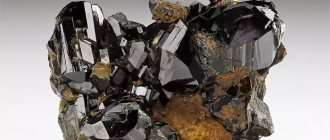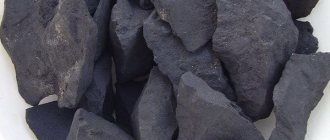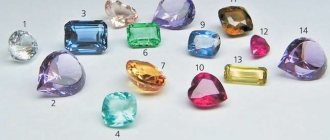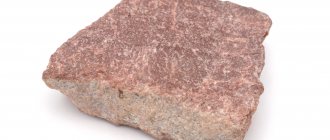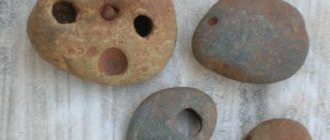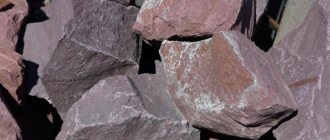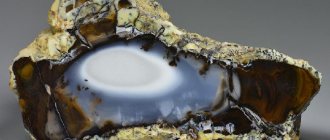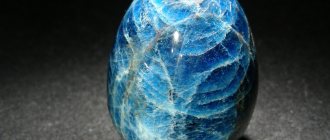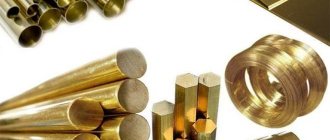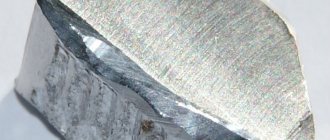The mineral sphalerite is a zinc sulfide, and a major source of zinc metal mining due to its high abundance. It is often called “zinc blende”, since the stone contains an accompanying admixture of iron, which, with different contents, significantly affects its appearance. For this reason, sphalerites are often confused with other minerals, such as galenas. And because of the wide range of colors characteristic of the stone, it also received many names, including pseudogalenas, “honey blende”, “ruby blende”, marmarites, cleiophanes and others. All these minerals are essentially subspecies with different colors and accompanying metals in their composition.
History of the stone
Sphalerite has been known to people for a long time. Even in ancient Greece, during mining, this mineral was mistakenly mistaken for galena. The difference between them was that sphalerite did not contain lead. That is why, during a detailed study of the stone, it was given the name “sphalerite,” which is translated from ancient Greek as “trick, false, deceptive.”
Mineral – Sphalerite
Sphalerite was first mentioned in the works of Georg Agricola (around 1546), but the mineral received a full description only in 1959. Thanks to this, the stone began to be actively used in industry. It is used in the manufacture of picture tubes, luminous paints, signal flares, etc.
But jewelers avoid interaction with sphalerite. The stone is too fragile for any cutting, so jewelry with it is practically never found. If you manage to find some unique sample, it will cost enormously.
Sphalerite jewelry
Despite its diamond-like shine and external beauty, jewelry makers avoid working with sphalerite. The refusal to create jewelry is due to the fragility of the stone - it crumbles easily. However, some beautiful varieties are more convenient for cutting - they are used to make flat inserts and cabochons, which are subsequently used to make inexpensive jewelry.
The cheapness of the stone is explained by the fact that the mineral is by no means rare, but with prolonged wear it loses its beauty and dazzling shine.
Much more often, sphalerite is used in its raw form, decorating private collections and being a magical attribute for esotericists and magicians.
Sphalerites are fragile and treacherous minerals, which are famous for their ability to pretend to be other stones. Due to the zinc content, sphalerite is widely used in industry, benefiting people, and the magical and healing properties of the stone help owners overcome life’s difficulties and improve health.
Sphalerite deposits
As already mentioned, sphalerite is often found in nature. It can form in different geological conditions, so it can be mined from either sedimentary or high- and low-temperature hydrothermal vents. Sometimes the stone is even found in limestone.
Unique and beautiful specimens, which can easily be cut in half, are mined in deposits in Mexico and Spain. Such stones can be small crystals or reach a weight of 70 carats or more.
IMPORTANT! Small samples of sphalerite (up to 10 carats) are mined in the USA, Russia, Italy and sometimes in the Czech Republic.
History of sphalerite
The mineral's name refers to its "deceptive appearance", in ancient Greek the term "sphaleros" means "treacherous" or "deceptive". This is due to the fact that it is often found in polymetallic ores together with galenas and is confused with the latter. The lead-zinc rock contains more sphalerite, and in the copper- and sulfur-pyrite rock, galena replaces it, but it is very difficult to distinguish between the stones, which is a problem for copper smelters.
Physical properties
| Property | Description |
| Formula | ZnS |
| Impurities | Fe, Cd, In, Ga |
| Hardness | 3,5 — 4 |
| Density | 4.08 - 4.10 g/cm³ |
| Refractive index | 2,368 — 2,371 |
| singonia | Cubic |
| Kink | Uneven; very fragile |
| Cleavage | Perfect |
| Shine | Diamond |
| Transparency | Transparent, translucent |
| Color | Yellow, reddish-orange, greenish-yellow, gray, dark gray, almost colorless |
The composition of the mineral is varied. It contains impurities of zinc, iron, cadmium, sulfur and other compounds. The mineral is very fragile; when exposed to temperature, it quickly cracks, but practically does not melt. In UV rays it glows with orange fluorescence, but under mechanical influence it does not glow.
Physico-chemical characteristics of sphalerite
The composition of sphalerite includes compounds of zinc, sulfur, iron, cadmium, and indium.
Its crystals have a simple shape, or they are polysynthetic and spinel twins, dense cryptocrystalline or fine, medium or coarse-grained aggregates, shelllike intergrowths, spherulites, kidney-shaped colloform spherulite crusts. The structure of the mineral is very similar to diamond. Crystals have a tetrahedral or rhombic-dodecahedral or cubic system. — Advertising —
Color palette: from colorless and light yellow to red, gray and dark gray samples, with a diamond shine, transparent or translucent, fragile.
Hardness on the Mohs scale 3.5-4, specific gravity 2.36-2.37 g/cm3. The crystals have perfect cleavage and uneven fracture.
Sphalerite is decomposed by nitrate and hydrochloric acid. Some varieties exhibit fluorescence or triboluminescence.
Associated minerals are galenas, dolomites, quartz, barites, and similar minerals are galenas, wolframites, cassiterites.
Areas of application
Sphalerite is widely used in various areas of industrial production. Most often it is used as a source of zinc (which is where it is obtained from).
IMPORTANT! If technology allows, then impurities of rare and precious metals (silver, cadmium, mercury, indium, gold, manganese, etc.) are also extracted from the ore.
The peak of activity in the study of polymetal sulfides (lead, zinc and copper) occurred precisely during wartime, since ammunition (lead bullets, copper casings), as well as coffins, were actively produced from these components (and are still being produced).
Also read: Dolomite - a natural unusual stone
In non-war times, sphalerite is used in paint and varnish production in the production of zinc white, for the manufacture of picture tubes, and various luminous paints. The material is also used for galvanizing metal products.
IMPORTANT! With the development of technology, all of the above areas are increasingly abandoning the use of sphalerite, replacing it with other materials. So now you can find this material in work less and less often.
But sphalerite was practically not used in jewelry by our ancestors, and modern jewelers do not favor it either. The mineral is too fragile and vulnerable; any mechanical impact on it ends with it crumbling and cracking. Only single samples of stone are used to make jewelry, and even those cost a lot of money. So only collectors can afford them.
Applications for sphalerite
Sphalerite is the main raw material in zinc smelting, while cadmium, gallium and indium are additionally mined.
All of these metals are rare and expensive, but they are necessary for innovative developments in electronic systems. The steel is coated with zinc to prevent corrosion. Zinc is also alloyed with copper to produce a very valuable industrial alloy, brass. The paint and varnish industry uses zinc for the production of zinc white, luminous enamel and compositions necessary for instrument making.
Zinc is also an effective and efficient anti-inflammatory and antiseptic agent used in the pharmaceutical and drug manufacturing industries.
Sphalerites, which formed intergrowths with magnetites, quartz, chalcopyrites and galenas, are used as ornamental material. They are used to make decorative items and souvenirs. The so-called “chipmunk ore”, striped, unusual and beautiful, is especially popular for these purposes.
In jewelry, sphalerite is used to a limited extent because it is soft and brittle. After cabochon cutting, the inserts are used in rings, pendants, pendants, earrings, men's rings and bracelets. But, unfortunately, sphalerite does not retain its original appearance in such jewelry for long.
Mineral samples unique in shape and color are in demand among collectors.
Types of stone
Sphalerite has several varieties that differ from each other in properties and external characteristics:
- proustite (ruby blende) - this mineral is almost completely colored in a red hue, the appearance of the crystal resembles a ruby, it received its name in honor of J. Proust, a French scientist;
- cleiophane (honey blende) is a translucent or completely transparent mineral that has a yellowish, green-yellow or honey tint, does not contain iron, and is valued among collectors;
- prshibramite is a translucent mineral containing a large percentage of cadmium (about 5% of the total composition), the color of the stone is yellow;
- humuchionite is a crystal of a crimson hue, transparent, contains arsenic sulfide, therefore it belongs to the group of toxic compounds that are used in the production of paints and varnishes;
- marmasolite - the most fragile subtype of mineral of all, is a semi-decomposed ferruginous sphalerite;
- brunkite is a translucent crystal with a whitish or pale yellow tint;
- marmatite is an opaque mineral with a matte finish, painted black, contains a large amount of iron (20% of the total composition), received its name from the Marmato River in Peru, since it was first discovered precisely at its source.
Types of sphalerite
Sphalerite may contain impurities of various metals, which is why it is characterized by a wide range of colors and varied appearance, according to which the following types of stone are distinguished:
- Marmarites are opaque, black minerals with a high iron content;
- Marmasolites are partially destroyed marmarites with a low percentage of iron and high fragility;
- Przybramites are yellowish translucent specimens with a high percentage of cadmium;
- Cleiophanes are transparent crystals, colored honey, light yellow or greenish, and do not contain iron;
- Brunkites - can be whitish or light yellow, and are part of the alumina rock.
Medicinal properties
It is believed that almost all types of sphalerite have healing powers. However, the spectrum of influence of the stone is not particularly wide:
- The mineral can increase a person’s vitality and strengthen his immunity.
- Since ancient times, potions and infusions containing this mineral have been used to cleanse the blood and treat the gastrointestinal tract.
- Regularly carrying a small crystal with you helps get rid of insomnia and nightmares, normalize sleep and calm the nervous system.
- Black varieties of the mineral help treat colds and protect against hypothermia.
- Yellow and greenish stones help with vision problems.
IMPORTANT! Zinc ointment prepared from sphalerite helps overcome various skin diseases.
Healing properties
Sphalerites.
Photo: gem-sphalerite.com In lithotherapy, sphalerite is often used for general strengthening procedures. Depending on the color, the mineral can provide different therapeutic effects. Thus, stones of black or dark shades help strengthen the immune system and help relieve cold symptoms.
Yellow and gray minerals have a beneficial effect on the nervous system and help cure insomnia.
Advertising - Continued below
Magic properties
Magicians and esotericists call one of the main magical properties of sphalerite the ability to return negative and dark energy back to the ill-wisher. If someone is trying to cast a spell or evil eye on you, then carry a small sphalerite crystal with you, and all the negative force that was directed in your direction will be returned in full to the sender.
Also read: Aegirine - an extraordinary needle-shaped stone
It is quite possible that it is precisely because of this special property that sphalerite is practically not used in dark rituals, but is actively used for other magical purposes:
- Transparent varieties of the mineral are strong amulets against the evil eye and damage. They are able to protect the wearer from conspiracies, slander, gossip, injustice, and magical influences.
- Yellow sphalerite helps to gain hope, restore a positive outlook on the world, and literally change the wearer’s worldview for the better.
- Regularly wearing an amulet made of this stone helps to get rid of uncontrollable aggression, constant anger, fears, giving the wearer peace, tranquility and transforming his aura.
- Experts recommend wearing talismans with this mineral to those who are not too confident in themselves and want to develop leadership qualities, strengthen fortitude, and achieve certain heights in life. Any type of sphalerite (except black) can be used for this.
Properties and uses of the mineral
The areas of application of sphalerite are extensive:
- Chemical elements are obtained from it - zinc, cadmium, indium, gallium, alloys of brass, aluminum, bronze.
- In pharmacology it is used for the production of anti-inflammatory and antiseptic agents.
- In industry, they are used for the production of paint and varnish coatings (zinc white, fluorescent paints), tires, headlights, spotlights, LCD screens, LED screens for signaling equipment, for creating markings and signs on roads and highways.
- In construction - for the production of galvanized iron for roofs, power line supports, engineering structures (for example, fences on highways).
- For making jewelry (jewelers don’t like to work with it because it’s easy to damage when cutting).
Physicochemical characteristics
Sphalerite is zinc sulfide, chemical formula is ZnS. The composition may contain iron impurities.
The sphalerite crystal has the shape of a simple polyhedron and has a diamond luster. It dissolves in acid, cracks at high temperatures, and glows under mechanical stress (triboluminescence).
An interesting fact is that the reaction of a gem to high temperatures depends on how much iron it contains. If there is a lot of iron, the stone will melt very easily, but it is almost impossible to melt a pure mineral.
The structure of sphalerite is crystalline, similar to diamond, hardness on the Mohs scale is 3.5–4, density is 3.9–4.1 g/cm³, cleavage is perfect in 6 planes.
View this post on Instagram
Publication from Vladimir Ryuma (@ryumavova) July 29, 2022 at 12:40 PDT
Healing and magical properties of sphalerite
The gem gives peace and tranquility. Jewelry made from it should be worn by people who want to develop fortitude and leadership qualities.
Sphalerite is a powerful amulet; it is capable of reflecting negative energy directed at its owner and returning it to the sender. It is often used to create talismans and amulets, as it can create a protective cocoon around the owner.
Women should use beads or pendants made of light-colored stones as a talisman, and men should use tie clips or rosaries.
Healing properties of the mineral:
- improves the condition of skin diseases (eczema, dermatitis, allergic reactions);
- helps with diseases of the nervous system (headaches, migraines, insomnia, panic attacks, epilepsy, nervous disorders);
- has a good effect on the body’s immune system (increases immunity, helps in the treatment of ARVI, influenza, has an anti-inflammatory effect);
- can improve vision.
Who is suitable according to their zodiac sign?
Sphalerite jewelry will bring financial well-being to earthly zodiac signs (Taurus, Virgo, Capricorn). It is not recommended for Scorpios to wear stone products - they may develop a quick temper and conflict.
For men named Daniil, Alexey, the mineral will give masculinity, for women with the names Alla, Christina, Daria - it will give strength and energy.
Jewelry with mineral
Despite the fact that sphalerite is not even classified as a subgroup of semi-precious stones, when cut it is valued at very high prices. Due to its fragility and softness, this mineral is almost impossible to cut. If individual samples are found during mining, they are cut only by great professionals and not for the mass sale of such jewelry.
Individual cut stones can only be found from avid collectors. For example, a cut Spanish yellow sphalerite weighing 5 carats will cost you $500-600.
Place of Birth
Formation occurs in hydrothermal deposits, under the influence of average temperatures, and is also found among skarns, sedimentary rocks of igneous origin, and polymetallic pyrites. Sphalerite is adjacent to chalcopyrite, wurtzite, pyrrhotite, stannite, pyrite, galena, barite, quartz, magnetite, and calcite.
The deposits where this gem is mined are located in the countries:
- Czech Republic (Příbram);
- Germany;
- Poland;
- Italy (Carrara, Varese);
- Mexico;
- Spain (Cantabria);
- Kazakhstan;
- Russia (Caucasus, Eastern Transbaikalia, Urals, Primorye);
- Australia;
- SOUTH AFRICA;
- USA (New Jersey);
- Canada (Yukon).
How to distinguish a fake?
It is easiest for the untrained eye to confuse sphalerite with painted glass or plastic. You can distinguish counterfeit material from natural material by the following signs:
- a real stone will have more impressive weight than a synthetic fake;
- real mineral is fragile, it can be easily scratched or damaged even without the help of special tools;
- The structure and color of real stone is not uniform, so it may have color spots, irregularities, and abrasions.
IMPORTANT! Sometimes jewelers can cheat and use artificial sphalerite in some jewelry. Such a mineral is not a fake in the broad sense of the word, since it has a composition similar to natural stone. The only difference from natural sphalerite is that the artificial one was bred in the laboratory.
General information about the mineral
Many rocks and minerals have been known to scientists for quite a long time, and therefore are well studied. Sphalerite is one of these. This name was assigned to it back in 1847 by the German geologist Ernst Friedrich Glocker. “Deceptive” - this is how it is translated from ancient Greek. Why did Glocker name the stone this way?
The fact is that this mineral was very difficult to identify. Researchers confused it with galena, lead, or zinc. In this regard, the mineral sphalerite is also often called zinc or ruby blende. By the way, today it is widely used to obtain pure zinc - an incredibly valuable metal that reliably protects iron structures from corrosion and destruction.
The mineral sphalerite is a sulfide of divalent zinc. In nature, other elements of the periodic table are often mixed with it: cadmium, iron, gallium and indium. The chemical formula of the sphalerite mineral is ZnS. Its color varies widely: from almost colorless to amber and orange-red.
How to wear and care for products
A lot has already been said about the fragility of sphalerite. Therefore, it is important to immediately note that when using or wearing this mineral you need to be extremely careful:
- It must not be dropped, hit, scratched or otherwise impacted mechanically. The stone will quickly crack or even crumble.
- Do not keep the stone in the sun and do not allow it to be stored in places with sudden temperature changes.
- To clean sphalerite, use only cool running water and a soft cloth. After washing, immediately wipe the mineral dry.
- Store the crystal in special jewelry boxes with soft padding inside. It is advisable to wrap the stone in soft cloth or put it in a bag for further storage. This will help protect it from accidental scratches in a box with other jewelry.
Also read: Labradorite - the stone of the mysterious northern people
Ring with mineral
Origin story
The formation of deposits of sphalerite (zinc blende) occurs in the vicinity of various rocks; garnet and tourmaline can often be seen. The first descriptions of the mineral are quite old (1546), research was carried out by G. Agricola, a German ore explorer and metallurgist. He presented his works in the book “De natura fossilum”.
The scientist called the find “blende,” which means “blende.” The nugget received its modern name “sphalerite” much later, only in the middle of the 19th century. Translated from Greek, it means: deceptive, insidious, treacherous. The new term was introduced by E. Glocker, also a German.
Note! In nature, there is a “twin” of sphalerite - wurtzite, a formation similar in composition and chemical formula. When heated, the rock completely degenerates into sphalerite.
Compatibility with names and zodiac signs
(“+++” – the stone fits perfectly, “+” – can be worn, “-” – is strictly contraindicated):
| Zodiac sign | Compatibility |
| Aries | + |
| Taurus | +++ |
| Twins | + |
| Cancer | + |
| a lion | + |
| Virgo | + |
| Scales | + |
| Scorpion | — |
| Sagittarius | + |
| Capricorn | + |
| Aquarius | + |
| Fish | + |
The exact influence of sphalerite on individual signs of the Zodiac has not yet been established by experts. Reliable information about the influence of the stone on some representatives of the zodiac circle is given only in relation to Taurus and Scorpio:
- The mineral favors Taurus. This sign can wear a stone as a talisman or talisman, or keep it in the house. It will help attract good luck, improve health, and achieve financial well-being.
- Scorpios should avoid sphalerite, since regular contact with this stone will make them irritable and conflict-ridden.
Names that suit sphalerite:
- Alexander (Alexandra);
- Arthur;
- Victor;
- Maksim;
- Paul;
- Faith;
- Victoria;
- Galina;
- Daria;
- Catherine;
- Natalia;
- Tatiana;
- Pauline.
Is this stone right for you?
Colors and varieties
Some varieties of sphalerite at first glance resemble tungsten, tin stone, titanium iron ore and even precious gems, which is completely different from zinc, which can be smelted from a unique natural material.
The perfect natural material has a marble-white color and varying degrees of transparency. They can be completely colorless or colored in light gray, yellow, green, orange, red, almost black shades. The varieties are as follows:
Interesting things about the stone
Despite its little popularity in wide circles, sphalerite still remains a rather interesting mineral:
- Talismans and amulets with this stone are recommended for wearing by people who lack self-confidence. Surprisingly, this small crystal can awaken real leaders in some people who can achieve whatever they want in a short time. But for amulets you need to choose untreated stones of any color (just not black). Also, since ancient times, this mineral was used as a kind of “dream catcher”, i.e. relieved nightmares, insomnia and sent pleasant, peaceful dreams to the wearer.
- How high temperatures will affect the stone depends on how much iron is included in the selected sample. If there is enough iron, then the stone will melt, and if the mineral is pure, then it cannot be penetrated by any blowpipe. The purity of the stone is also indicated by the color of the sediment in the reduction flame: if there is a lot of cadmium in the sample, you will notice a red-brown coating; in clean samples, the coating is white.
History and deposits of stone
Sphalerite received its name in 1847 from the Greek word "sphaleros", meaning "deceptive", due to the fact that it resembles an ore of metals and is often confused with it.
The mineral is found in hydrothermal deposits and is part of polymetallic ores.
The main deposits are located:
- in Poland;
- Russia;
- Germany;
- Italy;
- USA;
- Mexico;
- Australia;
- Kazakhstan.
The stone is mined by open-pit mining using manual labor and processed with carborundum heads.
In the video, a specialist processes the mineral and talks about its features:
Diagnosis of sphaleritis
Sphalerite is quite easy to identify in almost all cases. However, given its high prevalence, it is possible to recklessly mistake similar ore minerals for sphalerite. Characterized by low reflectivity, especially its strong decrease with immersion, massive internal reflections, medium hardness and etching behavior. However, in a good thin section of a very fine-grained sphalerite, the magnetite next to it may be missed (in immersion this error can be immediately established) or the rare alabandine may be confused with it; it reveals predominantly dark green internal reflexes, but much rarer. Minerals similar in reflectivity - cassiterite and rutile - are much harder and anisotropic. It cannot be reliably distinguished from wurtzite in polished sections. The “ice flower structure” that appears in wurtzite during etching is often found in sphalerite, which often appears as a pseudomorph of wurtzite. Thus, “wurtzites” from Příbram, present in almost all collections, despite their completely typical structures, are usually sphalerite; The situation is similar with some radiant “wurtzites” contained in “shell-like blendes.”
Occurrence in deposits
As one of the most common ore minerals, sphalerite is extremely widespread in deposits of a wide variety of origins. Due to its high sensitivity to oxidation, it is absent only in placers and at outcrops of sulfide ores, generally mostly in sedimentary formations, not counting those that are within the “sulfur cycle”. But wherever the formation and preservation of sylphide minerals is possible at all, sphalerite is also present.
In intramagmatic formations, sphalerite is extremely rare; in ordinary silicate rocks it is found only in minor quantities and together with more abundant chalcopyrite. In magmatic segregation deposits of pyrrhotite and pentlandite it is not uncommon, but for the most part it is much later than the bulk of other ore minerals. It is found only in the form of “sphalerite stars” in chalcopyrite in very early formations. However, the small amount of zinc in the rocks of the earth’s crust has not yet been fully elucidated geochemically. Its distribution in the “charnockites” is remarkable.
Types of minerals
Zinc blende in nature is represented by several varieties:
- marmatite (a black compound characterized by a large amount of iron);
- cleiophan (yellow, without iron impurities);
- brunkite (white mineral);
- marmasolite (with a small amount of iron);
- prshibramite (yellowish-transparent color with a significant amount of cadmium).
Magic characteristics
In addition to its medicinal properties, there is a version that sphalerite also has some higher powers. They help the owner of the mineral get rid of manifestations of anger and instill peace and hope in a person. Magicians use black minerals to establish connections with the forces of darkness, and white stones are used in the form of amulets and amulets that protect a person from witchcraft.
Sphalerite is used in various fields: in science, industry, medicine, and in the magical field.
The school curriculum examines not only zinc itself, but also its compounds, method of production, physical and chemical characteristics. For example, at the final certification in the 9th grade, children are given the following tasks: “Determine the mass of zinc blende required to obtain 1 kg of pure metal if the ore contains 10% impurities.”
In order to solve the proposed problem, the guys first use proportions to calculate the mass of zinc sulfide in the ore, then draw up a scheme for obtaining the metal by oxidizing the ore, followed by reduction with carbon monoxide, hydrogen, and metal. In addition to calculations, students gain an understanding of the chemical properties of medium salts, which include zinc sulfide.
Applications and stone products
Rarely are any specimens used in jewelry, for making jewelry (earrings, rings, beads, bracelets). The gem is placed in gold and silver in the form of cabochons and flat inserts. Basically, the rarest specimens of the mineral are collected by collectors and stored in museums. Lithotherapists, magicians, and esotericists use it in their work.
The main use of sphalerite is in industry and is considered the main source of zinc. Titanium, germanium, silver, cadmium, nickel, mercury, gallium, and indium are obtained from polymetallic ore.
Deposits and production
Batch formations of natural material and its extraction are carried out in many countries; the mineral is not considered a rarity: Germany, Czech Republic, Poland, Italy, Spain, Australia, Namibia, Canada, Austria, Kazakhstan, South America, Mexico and Russia (Ural, Transbaikalia).
Spanish varieties that have jewelry value are considered especially valuable. They are mined by hand. Some properties of such nuggets are superior to cut diamonds.
This is interesting! The mine in the city of Franklin (USA) is rich in sphalerite-cleiophane; such stone is not formed anywhere else in the world.
